Edgar Degas
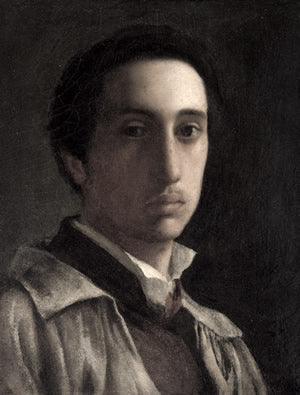
| Birth Name: | Hilaire-Germain-Edgar De Gas. |
|---|---|
| Artistic Name: | Edgar Degas. |
| Nationality: | France |
| Year of Birth: | 1834, Paris. |
| Year of Death: | 1917, Paris. |
| Style: | Realism and Impressionism. |
A draughtsman, sculptor, and historicist painter by training, but transformed into contemporary realism with tinges of impressionism by conviction. A virtuoso in classical academic technique, yet modern in his search for images. Often named as one of the founders of Impressionism, it is clear that he does not belong to the small group of "pure impressionists," like Monet, Pissarro, or Cézanne.
Degas is one of those painters with a unique style, a specialist in capturing the movement of the body, to an almost obsessive point: more than half, about 200, of all his works are set in the Ballet, of which 80% show behind the scenes.
Degas' Paintings
The works of Edgar Degas are of great technical quality and the personality of the author is characterized by his incessant search for beauty. These aspects converge in this unique man in his way of making art, always personalistic, therefore it is not possible to analyze him taking into account only the existing styles, currents, and movements.
-
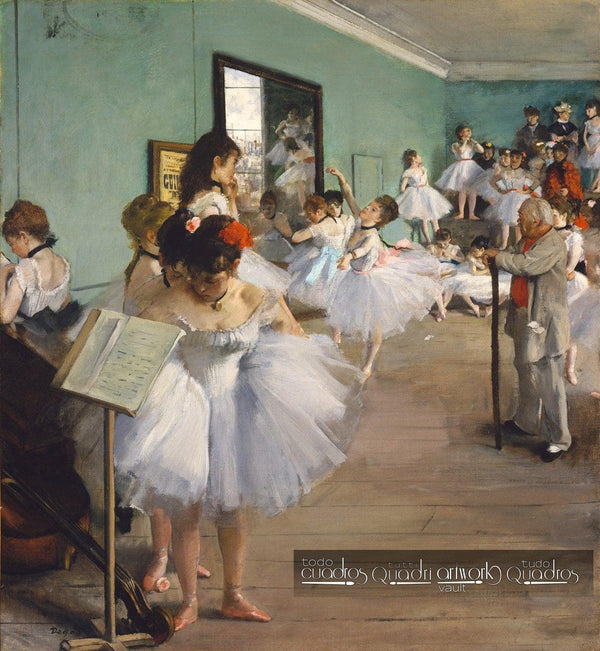
Author: Edgar DegasStyle: RealismOriginal Title: La Classe de danseTitle (English): The Dance ClassType: PaintingTechnique: OilSupport: CanvasYear: 1874Location: The MET Museum, New York.This, along with the next painting with the same title (in the Musée d'Orsay), are the 2 most elaborate ballet paintings that the artist created,
It portrays an imaginary scene, in the rehearsal room of the Paris Opera. It shows ballet students with their mothers, who are in the room on the occasion of the exam day.
-

Author: Edgar DegasStyle: RealismOriginal Title: La Classe de danseTitle (English): The Ballet ClassType: PaintingTechnique: OilSupport: CanvasYear: circa 1873Location: Orsay museumA very similar version to the previous painting, the same perspective and situation. The only character who remains in the same position is the ballet teacher Jules Perrot, very famous in his time.
-
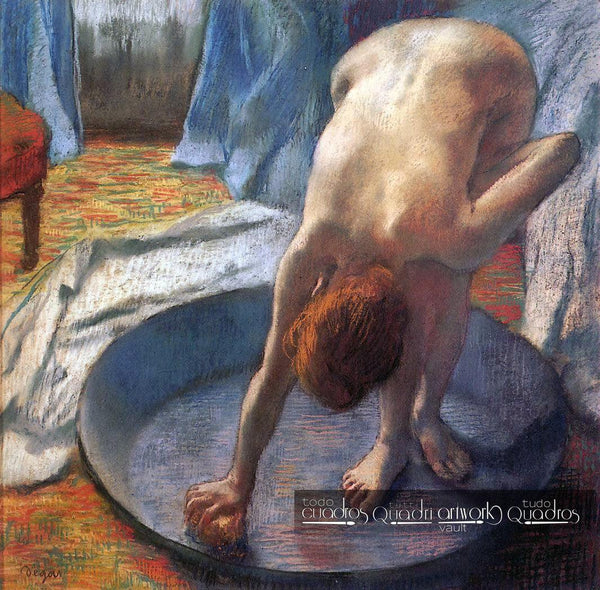
Author: Edgar DegasStyle: Realist ArtOriginal Title: Le tubTitle (English): The TubType: PaintingTechnique: PastelSupport: PaperYear: 1886Location: Hill-Stead Museum, Connecticut, USA.This is one of the designs from the series of women bathing in tubs and bathtubs. Part of the inspiration for these motifs was found in Japanese prints, of which Degas was an avid collector.
All of them have their faces hidden from the viewer. The facial expression in this case is dispensable, the artist seeks to concentrate attention on the activity, the anatomy, and the action of the characters.
-

Author: Edgar DegasStyle: ImpressionismType: PaintingTechnique: OilSupport: CanvasYear: circa 1873Location: Harvard Art Museums complex, Boston.This is one of the first works with the theme of dancers, a theme he would develop extensively throughout his career.
When the art critic Edmond de Goncourt visited Degas in his studio, he said of him: After great trials, experiments and test shots in all directions, he has fallen in love with modern life, and from all the themes of modern life, he has chosen women bathing and dancers."
-

Author: Edgar DegasStyle: Realism and ImpressionismOriginal Title: Répétition d'un ballet sur la scèneTitle (English): The Rehearsal of the Ballet on StageType: PaintingMediums: Oil, watercolor, and pastelSupport: Canvas mounted on boardYear: 1874Location: The MET Museum, New York.There are three known versions of this same painting, two of them in the MET in New York and one, in black and white, in the Musée d'Orsay, Paris.
It depicts the general rehearsal with the excitement and all the elements that will be used in the final performance: scenery, costumes, hairstyles, and lighting. The play of light and shadows, a recurring element in his creations, is prominent.
-

Author: Edgar DegasStyle: Impressionism and RealismTitle (English): Orchestra MusiciansType: PaintingTechnique: OilSupport: CanvasPainted in: 1872 and retouched between 1874 and 1876Location: Städel Institute, Germany.While the original painting was in the possession of a personal friend of the painter, two years after gifting it, he asked for it back to make some changes. The result was a complete reorganization of the characters.
He removed 5 cm from the left and right, while adding a strip of canvas about 20 cm at the top, to work on what are now the girls on the stage.
What is interesting about this work is that it presents a proposal of contrasts on several levels, including style, as the dancers are painted in an impressionist manner and the musicians in a realist way. Other contrasts include light and shadow; innocence and maturity; grace and seriousness; feminine and masculine.
-

Author: Edgar DegasStyle: RealismGenre: Historical PaintingOriginal Title: Le Bureau de coton à La Nouvelle-OrléansType: PaintingTechnique: OilSupport: CanvasYear: 1873Location: Museum of Fine Arts of Pau, France.This genre painting was the first the artist managed to sell to a museum, marking a before and after in his career. From now on, he begins to strive for recognition and to live off the income generated by his works.
The scene is set in a real environment, specifically in the cotton business run by his uncle Michel Musson.
-
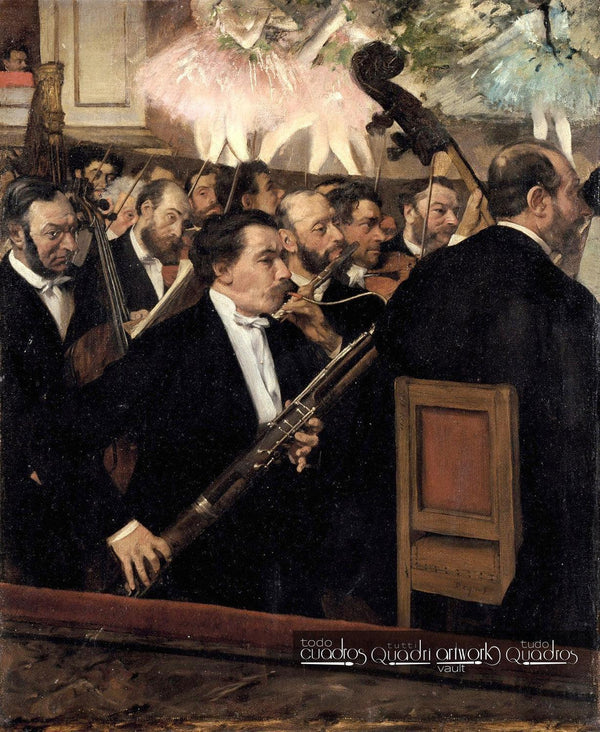
Author: Edgar DegasStyle: RealismOriginal Title: L'Orchestre de l'OpéraType: PaintingTechnique: OilSupport: CanvasYear: circa 1870Location: Musée d'OrsayThis is a multiple portrait featuring the bassoonist Désiré Dihau, a personal friend of the author.
At the top, like angels, one can see the sparkling and moving tutus; on the other hand, all the other members of the orchestra have a slightly pusillanimous expression and also all play the same type of instrument, all of which strongly exalts the central and protagonist figure of the work.
-
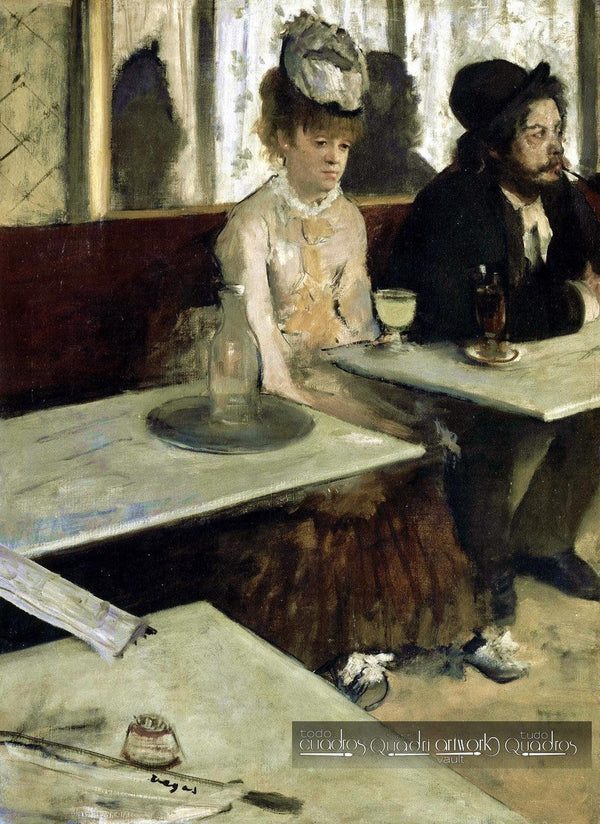
Author: Edgar DegasStyle: RealismOriginal Title: L'AbsintheAlso Known As: In a Café, also called The AbsintheType: PaintingTechnique: OilSupport: CanvasYear: 1876Location: Musée d'OrsayA double portrait with all the aesthetics of the era, it shows two characters looking like strangers, the woman with her gaze lost in nothingness and the man looking elsewhere. She has what is assumed to be a glass of absinthe in front of her, a drink that at the time had a terrible reputation, associated with leading people to psychosis.
One of the most likely interpretations is that the artist made a subtle criticism of absinthe consumption. The painting was created in the artist's studio, using models and artificially placing them in a real location he knew: La Nouvelle Athènes, Paris.
-
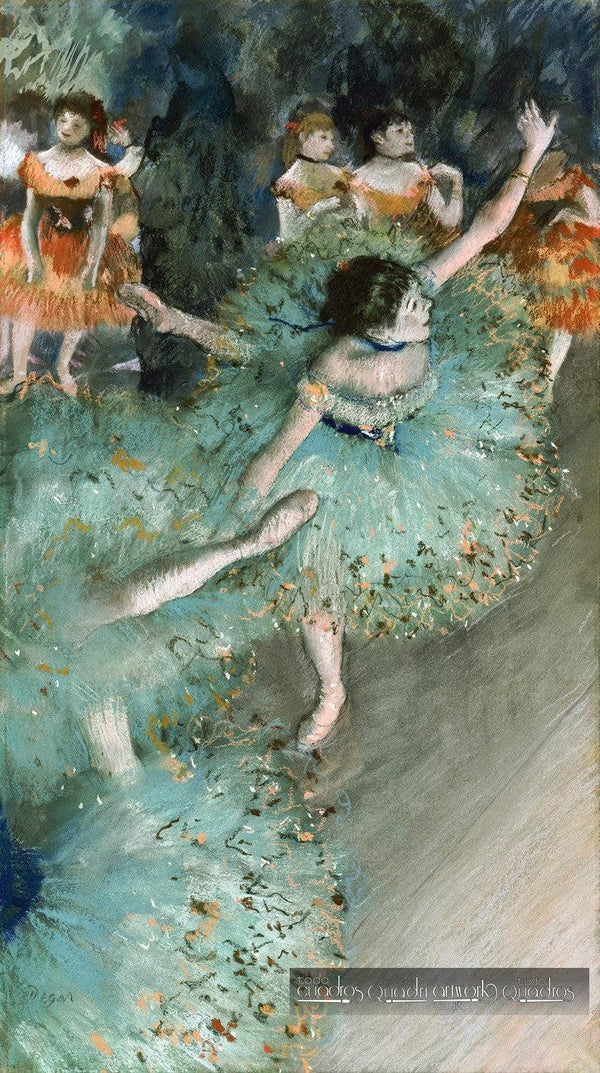
Author: Edgar DegasStyle: ImpressionismAlso known as: Green DancerType: PaintingTechnique: OilSupport: CanvasYear: circa 1879Located at: Museo Thyssen-BornemiszaThis is one of the artist's most recognizable works at first glance, widely used for printing decorative sheets.
-
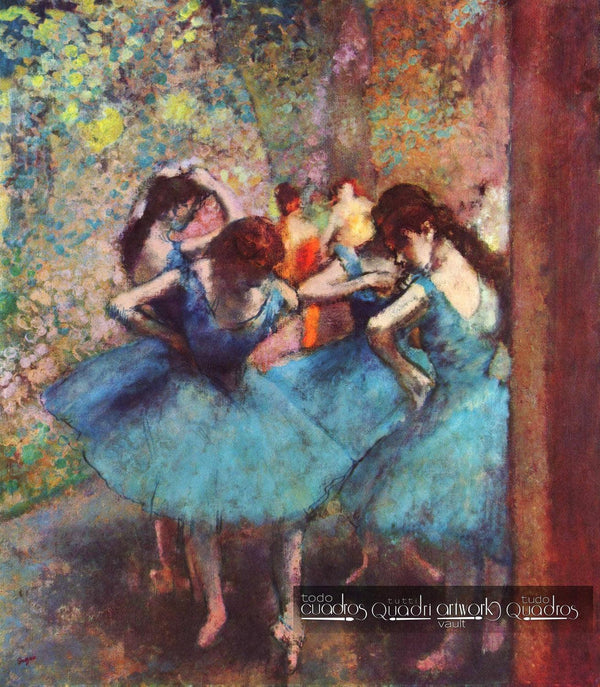
Author: Edgar DegasStyle: ImpressionismOriginal title: Ballerine bluType: PaintingTechnique: OilSupport: CanvasYear: 1893The author makes use of a very marked impressionist stylistic, using thick patches of color to compose the graceful figures and light effects. The characters seem to be behind the curtain (which is seen on the right), preparing to go on stage.
-
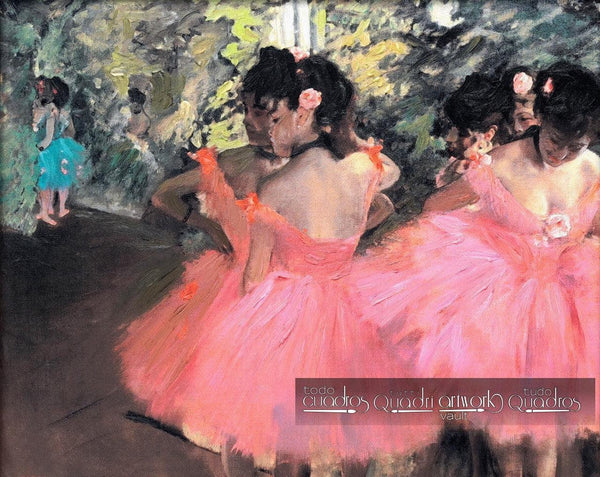
Author: Edgar DegasStyle: ImpressionismTitle (English): Dancers in PinkType: PaintingTechnique: OilSupport: CanvasYear: circa 1883Located at: Hill-Stead Museum, Connecticut, USA.For many critics, this is one of the painter's most beautiful works. It has been the subject of extensive analysis regarding the proportions and anatomical positions used.
A notable aspect is the natural journey the eye makes when observing the canvas, starting from the right and moving to the center, then to the left, but upon realizing that what the dancers are looking at does not appear in the painting, the eye returns to the center and exits to the right.
Order it in the section of Degas oil paintings
Famous painters related:
↑Back to top
